Public Pier — No Fishing License Required
Closed since 2014 — Awaiting repair and/or reconstruction. A prime example (perhaps the perfect example) of government inefficiency, in this case the California State Parks Department. For years there have been promises of repair and reopening but as of the start of 2023, nothing has happened.
Back in 1769, soldiers of the Portola Expedition shot a seagull at this windy spot and then named their campsite “La Gaviota” (Spanish for seagull). Today, there is still a lot of wind, a lot of sea gulls, many, many campsites and this popular small pier. However, the pier has been closed since 2013 while waiting for repairs by the state.
A mid-summer visit in 1990 was one of my most interesting sojourns to this pier. Like most anglers, I had started fishing in an area just outside the breakers and was hoping for a halibut (yes, I was fishing for the halibut). I had two poles and the heavier one was my halibut pole. The light pole was my potpourri pole; it was baited with small hooks and small baits. I had caught nothing on my heavier outfit. I had caught a small kelp rockfish and an under-sized kelp bass on the light pole. Since nothing much seemed to be biting in the areas I was fishing, I decided to move out to the mid-pier area.
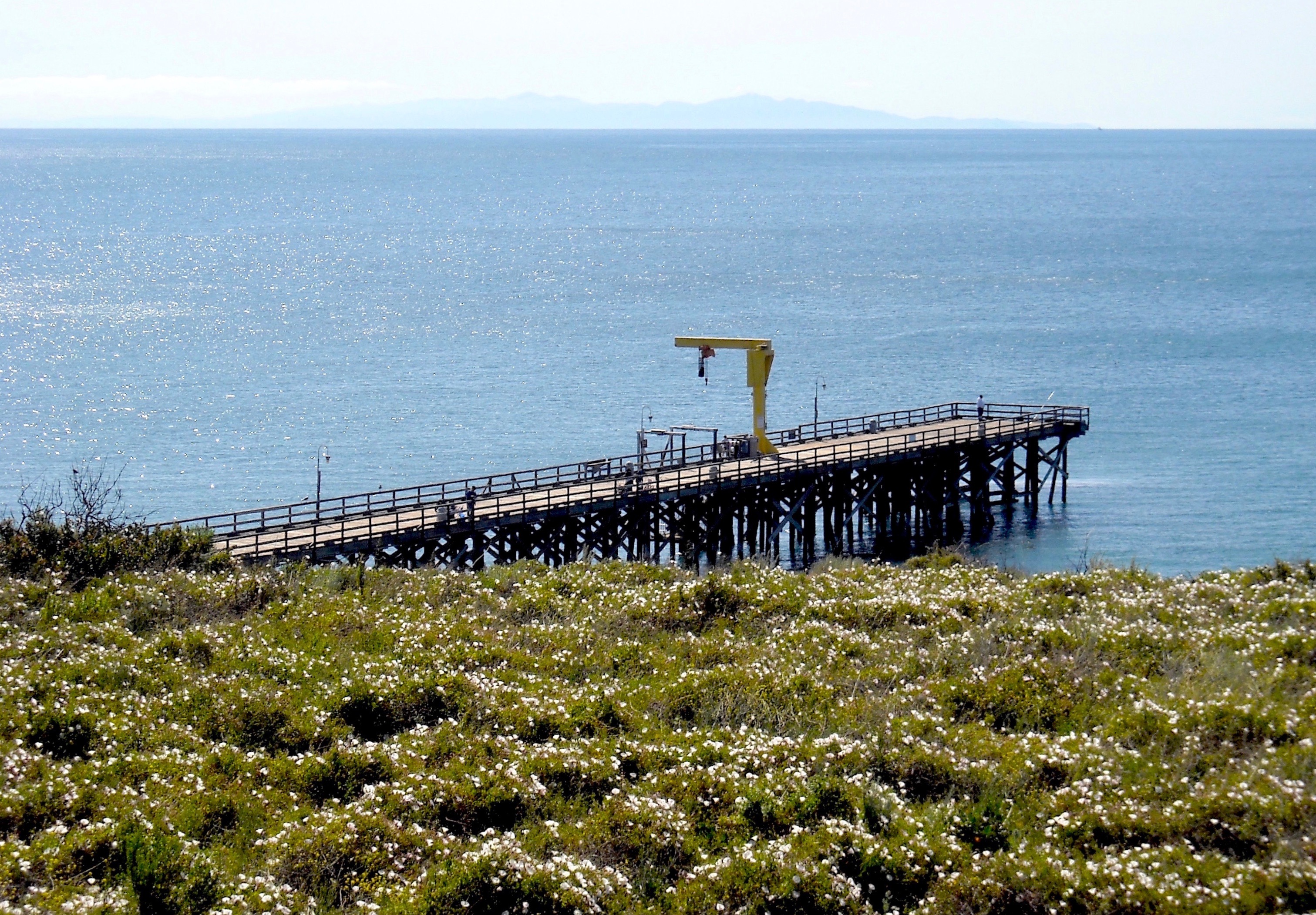
The pier with Santa Rosa Island off in the distance
It was obvious why no one was fishing this area. Mid-pier to the end of the pier the water was virtually covered with kelp. In fact, it looked like a pier had been plopped down in the middle of a kelp forest. I decided to try my light outfit among the leaves and stalks of the giant kelp and hoped that if I hooked a large fish I would be able to keep it out of the kelp. Soon, I had a hard hit and after a short struggle, I hauled in a giant kelpfish nearly 20 inches long (they grow to 24 inches). It was the only kelpfish I was to catch that trip. Unfortunately, I had used the last of the mussel bait and was unable to get the fish to strike any other bait.
But the fish were there. A small school of tiny pinhead anchovies lazily swam around the kelp; whenever they neared a leaf a kelpfish would dart out and attack the school. Some of the kelpfish were bright red, some purple, some a bright green. Watching closely I could see the fish dart in and out, then retreat quickly to the protection of the kelp. I could also see bright red crabs on the stalks and every so often a larger perch or bass would dash in among the kelpfish. I’m convinced that if I would have had proper bait — fresh mussels, bloodworms, or small crabs, I could have caught a good “mess” of fish. Unfortunately, I had neither proper bait nor the time to get any, I had to move on.
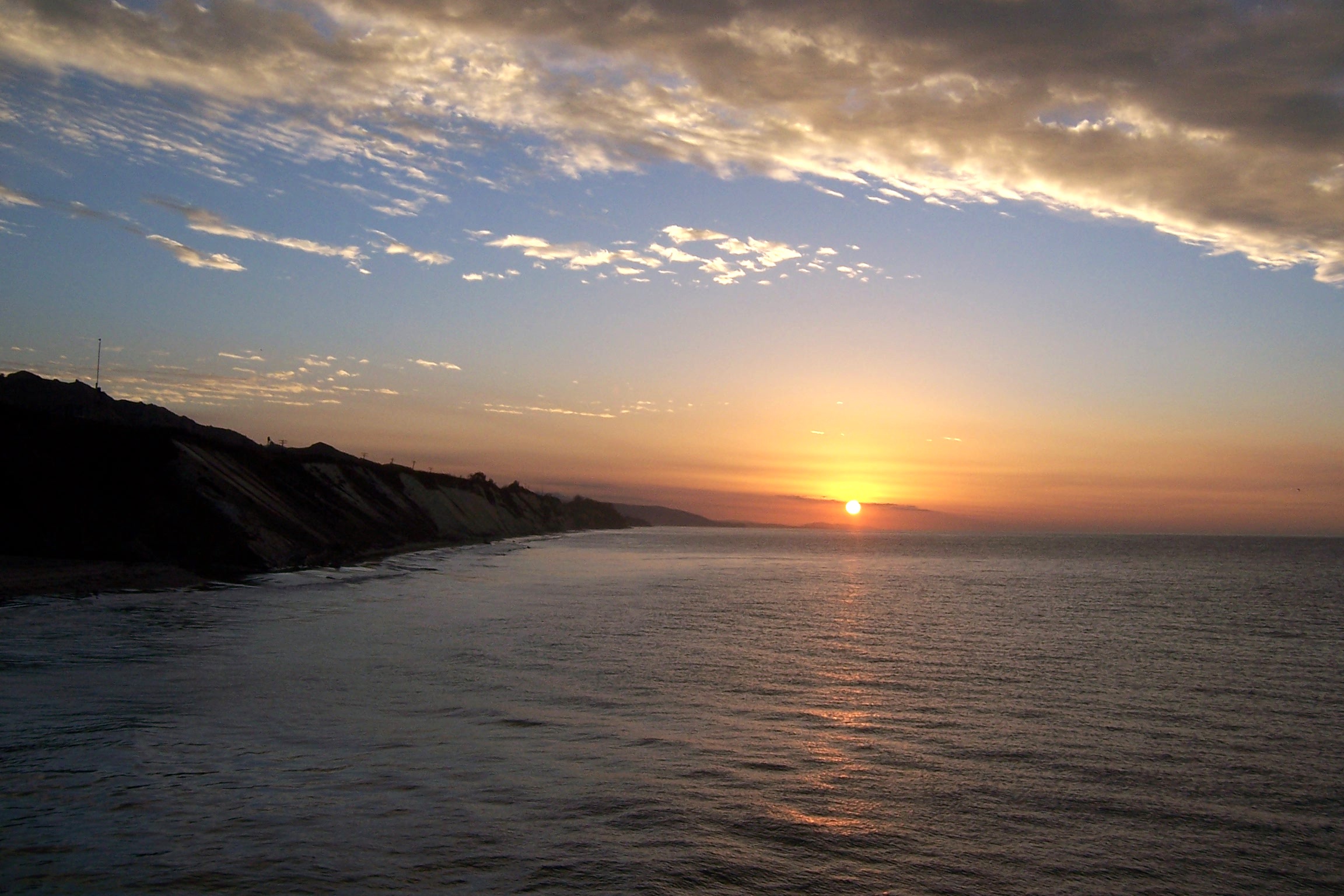
Dawn and the view looking down the coast
Environment. The pier is the last of the warm-water southern California piers and is part of the 2,775-acre Gaviota State Park, a park that stretches along five miles of California’s shoreline and receives on average 55,000 visitors per year (so it’s not too crowded). The park is roughly 45 minutes west of Santa Barbara, and presents most days a glimpse of the nearby Channel Islands off to the south—San Miguel (the closest), Santa Rosa, and sometimes Santa Cruz. A short distance west of the park HY 101 turns inland as you pass through the Gaviota Tunnel and you lose your seaside view until you reach Pismo Beach. The tunnel by the way is perhaps most famous from the scene in the movie The Graduate when Benjamin Braddock (Dustin Hoffman) drives his beautiful new Alfa Romeo through the mist and into the Gaviota Tunnel.
Approximately 15 miles away sits Point Conception (called by early day sailors the Cape Horn of the Pacific due to the treacherous northwest gales that sweep around the headland). It is the traditional dividing line between the subtropical warm-water south and the temperate cold-water north. The “Point” is also where the coastline begins a north-south orientation instead of the east-west direction common for much of southern California’s coastal areas. The Gaviota Pier itself faces due south.
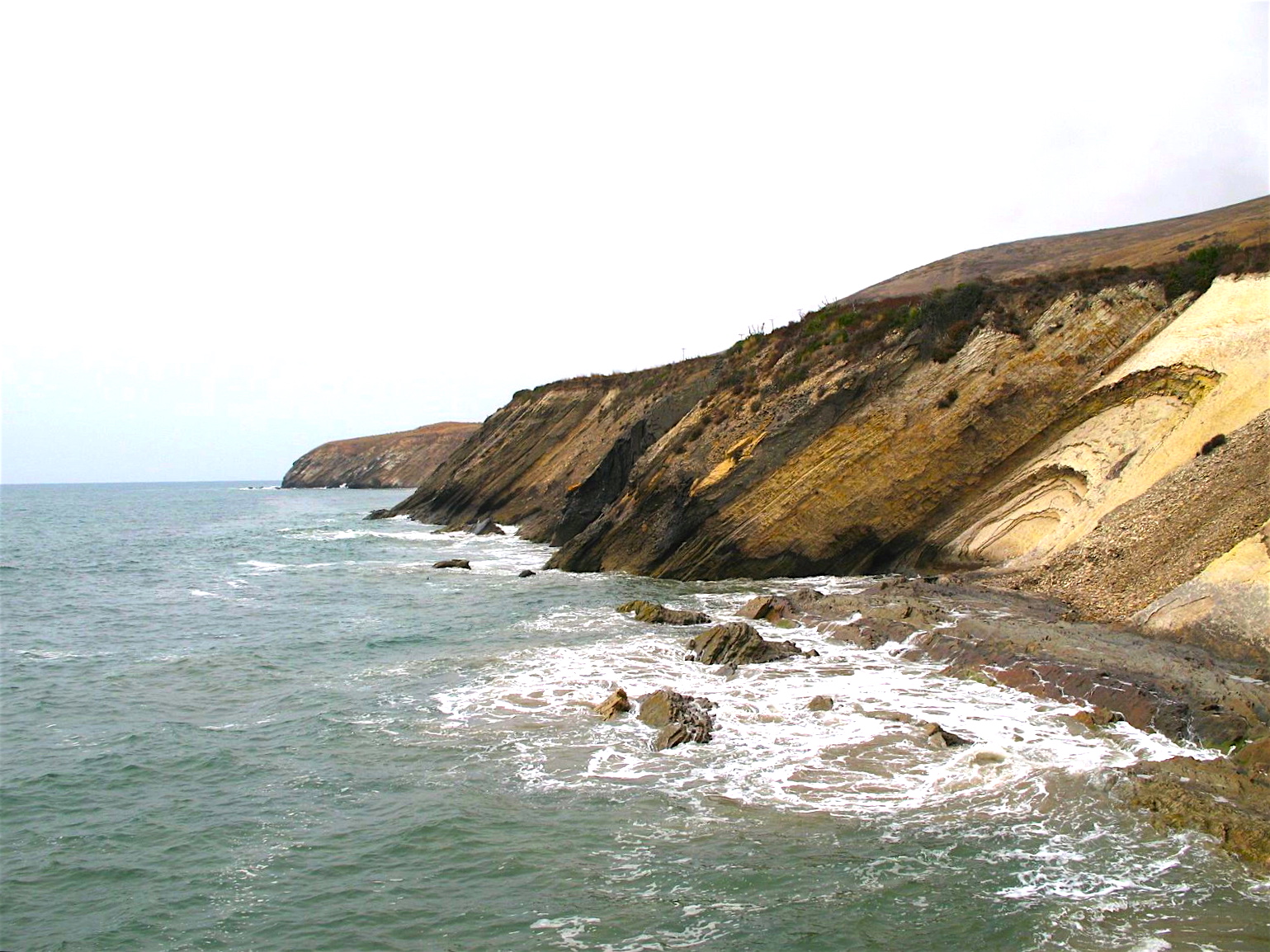
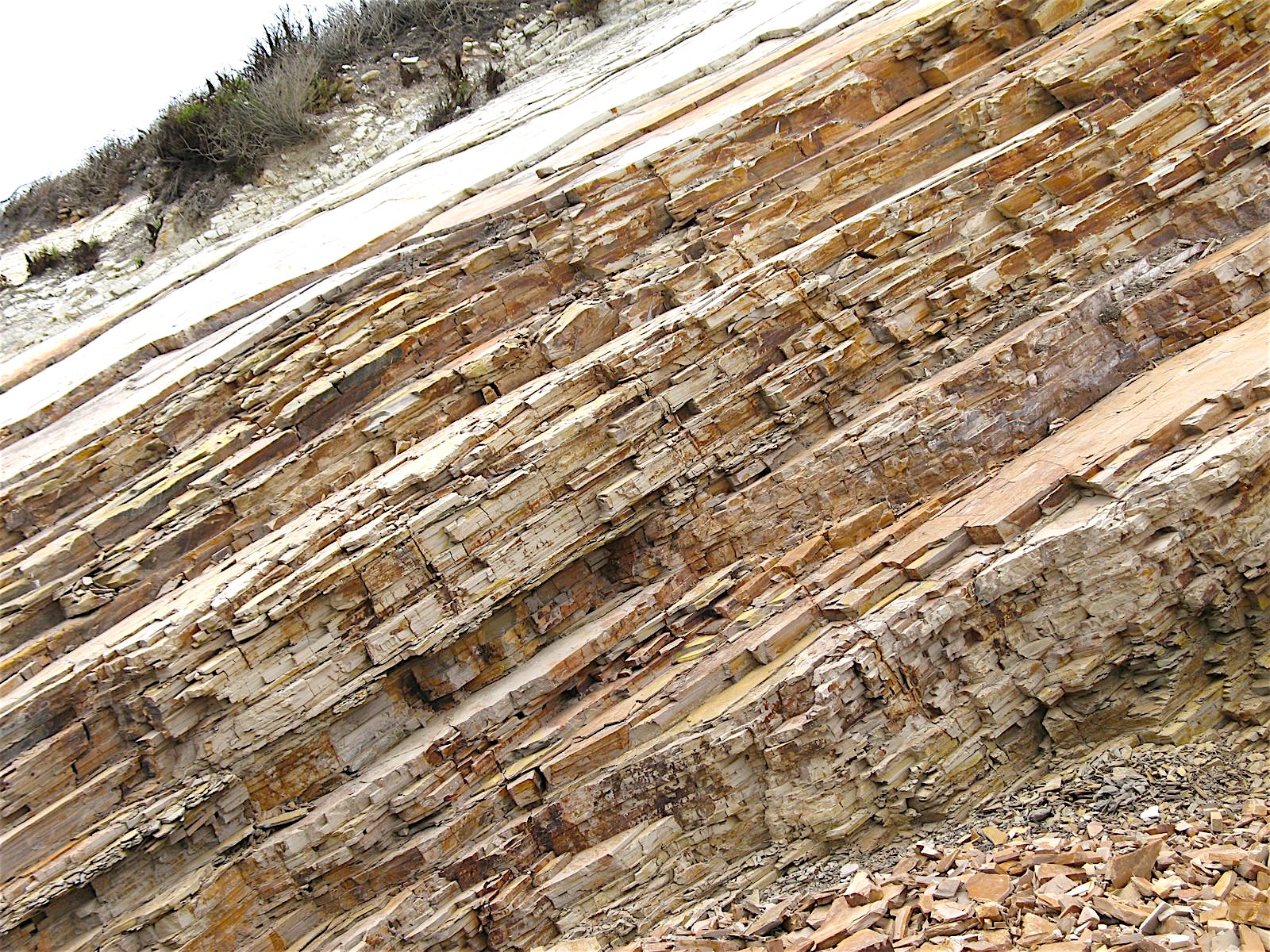
Looking up the coast
The shoreline is edged on the west by Monterey shale that emerges out of the ocean’s floor to form interesting patterns both on the beach itself and the cliffs above. Photographers (and anglers) are presented some beautiful colors and great photo ops during the late afternoon and sunset hours. Instead of the “white cliffs” of Dover you’re presented the “golden cliffs” of Gaviota.
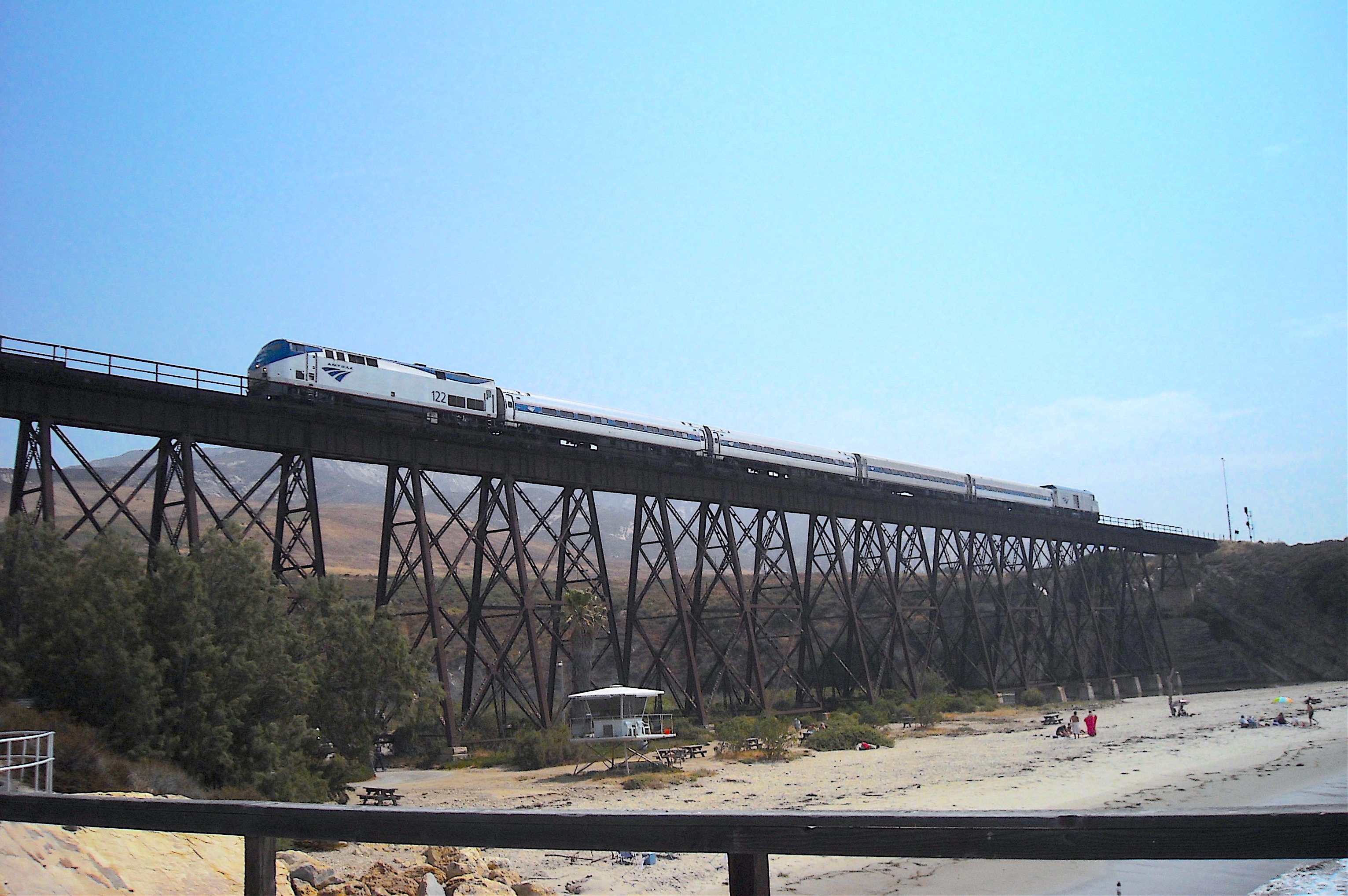
To the east of the pier is the sandy-beach surf area framed by the high Southern Pacific railroad trestle (aka the “ghost bridge”). The trestle bridges Cañada de la Gaviota and Gaviota Creek, a seemingly unassuming creek that is usually dry by summer. However, as witnessed by the devastation caused to the park in 1998, the creek can play a Jekyll and Hyde role during winter storms.
As for the ocean environment, most of the bottom around the pier is sand with few rocks to grab onto sinkers—or to attract fish. Inshore the water is shallow but at the end of the pier the depth is approximately 20 feet deep. Pilings are usually covered by mussels and the creatures associated with piling environments. Some years will see a dense growth of kelp surrounding much of the pier; other years may see little or no kelp.
The pier has a listed length of 529 feet; width is 21 feet and the deck is 18 feet above the water. There are two annoyances at the pier, both small and too plentiful. The first is yellow jackets and this is one of the worst piers for the critters. If you are cutting bait on the railings the hovering pests will visit you. Ditto if you have food. Keep bait, food, and fish you catch in a cooler to avoid the insects. The second nuisance is shinerperch that almost always seem to saturate the waters of the pier from mid-pier to the end. No matter the fishing, good or bad, the shinerperch will be present and eager to grab any bait that is small enough for them to mouth. Problem is they will grab the baits intended for larger perch much like senorita will do at some piers. You can’t avoid them without using large hooks but you need small hooks for the perch. Their presence should attract larger fish and that seems their only redeeming virtue.
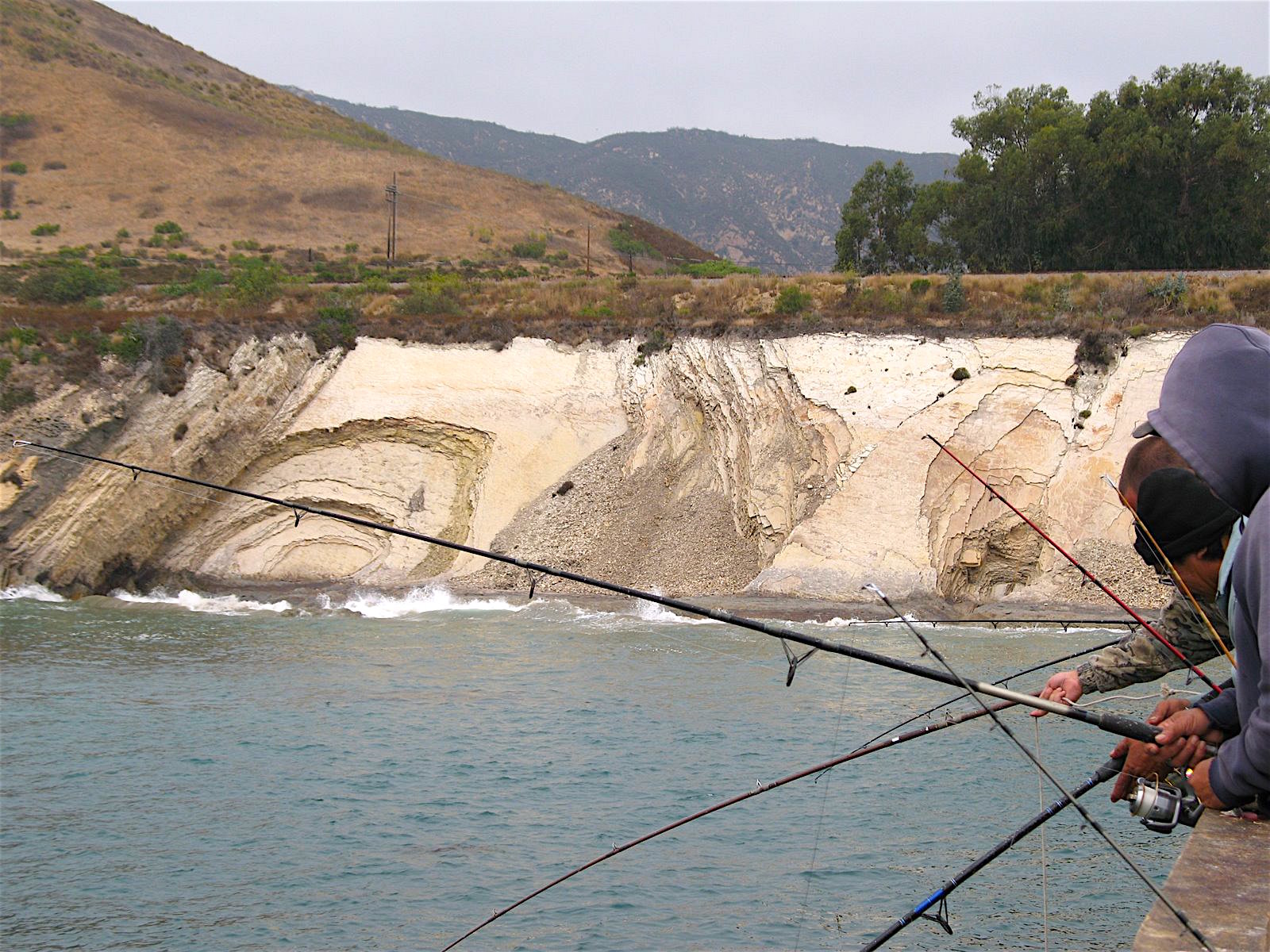
Fish. The inshore, surf area is the home of and produces good catches of surfperch (several varieties), rays, guitarfish and sharks. Just outside the surf area to mid-pier, where water is free of kelp, is the spot most often fished for halibut and quite a few are landed every year (although more should be landed). Mid-pier to the end, especially around kelp and the pilings, anglers will land several varieties of perch, small rockfish, bass (mainly kelp bass), an occasional sculpin (scorpionfish), as well as the aforementioned sharks and rays. The far end yields more of the deeper-water pelagic species: Pacific mackerel and jack mackerel every year, sardines and Pacific bonito some years.
The deeper water is also the main home of sharks and rays, large and small, with a variety being caught. The specialty is thresher sharks and the pier may be the best in the state for threshers—Alopias vulpinus—the fox of the sea. Although threshers typically cruise from almost the breakers out to the outer edge of kelp beds, here the most common hookup spots are out toward the end and some days will see multiple hookups of the large critters.
Crustaceans. Unlike piers to the north, and a few SoCal piers to the south, the pier has never been noted for crabs or lobsters. The one exception is that the pier does see some good-sized spider crabs (aka sheep crabs) taken by anglers. Although not as productive as Stearns Wharf in Santa Barbara, I’ve gotten quite a few reports of the big gnarly, ugly-looking crabs being landed here. On the other hand, I don’t believe I’ve ever heard of a lobster being taken from the pier even though Gaviota was an area where commercial lobster fishermen used to unload their catch. Given that fact, some should be in the area.

Fishing Tips. Inshore, the surf area will produce barred surfperch for anglers using sand crabs, pile worms or bloodworms, fresh mussels or clams. The same area and baits will also yield some black seaperch, rubberlip seaperch, kelp rockfish, grass rockfish, brown rockfish, and a few kelp bass when and where kelp is present. Although the bottom is sandy, the kelp works to attract rock-frequenting species. The same fish, as well as pileperch, can be caught around the pilings themselves by using a high/low leader and size 6 or 4 hooks baited with sea worms or mussel. Bait rigs will also work here, but the most common fish will be shinerperch, kelp seaperch, small walleye surfperch, and jacksmelt.
Just outside the surf area is the spot for halibut. Although most anglers will use a whole or cut anchovy on the bottom, live bait (small smelt, sardine, tom cod or shinerperch) is often more productive. Another technique is to troll your bait along the bottom if the pier isn’t too crowded. Simply keep your line taut and walk along the edge of the pier. The halibut like to lie in the near the pier, especially in the depressions between the pilings. Be careful not to tangle your line in the pilings and be ever so alert for the soft mouthing of a halibut. Generally they like to take the bait and move it around a bit in their mouth before they really strike. Be prepared! The same technique can be used quite effectively with artificial lures, especially swim baits like Big Hammers.

A halibut caught by my friend Glen (Songslinger) one morning — the rocks behind his shoulder have always looked to me like some sort of misshapen, skull-like head
Further out on the pier, areas in the water are sometimes covered with kelp. When this happens, it takes care and patience to fish the spots between the fronds of kelp. Use a small size 6-8 hook, mussels or seaworms for bait, and fish right around the kelp. Seaperch, opaleye, halfmoon, and more exotic species like kelpfish and senorita will often bite. Calico bass (kelp bass) are also a possibility and an 11-pound calico was reportedly caught near the crane by an angler fishing at night in July of ’04. Don’t know if the weight was accurate but that’s a nice-sized bass!
The far end will often yield pelagics—Pacific mackerel, jack mackerel, jacksmelt and sardines. The most common rig for these is a multi-hook bait rig like a Lucky Lura or Sabiki. Myself? I prefer just throwing a couple of size 4-2 hooks onto a line high/low style with a one-ounce shiny torpedo sinker at the bottom. It catches fish and why risk losing an expensive bait rig if the mackerel begin one of their patented “mac attacks.” Bonito will be caught some years and when they show up break out feathers with Cast-A-Bubbles, golf-ball rigs, or spoons and lures like MegaBaits. Kelp bass can also be taken on lures and surprisingly some years will see quite a few lizardfish hitting the artificials.
I have experienced some absolutely unbelievable catches of mackerel off the far right corner (generally early in the morning) but almost anywhere at the end can be good when the macs are running (as well as jack mackerel, jacksmelt and sardines).
Wintertime, while generally offering up slower fishing than during the summer and fall, does offer up an occasional lingcod—or so I’ve been told. Since lings move into shallow waters in the late fall to winter months to spawn it makes sense that some would show at the pier. Cabezon too may make an appearance. Use squid or a small live fish for the lings, crabs or fresh mussels for the cabezon.
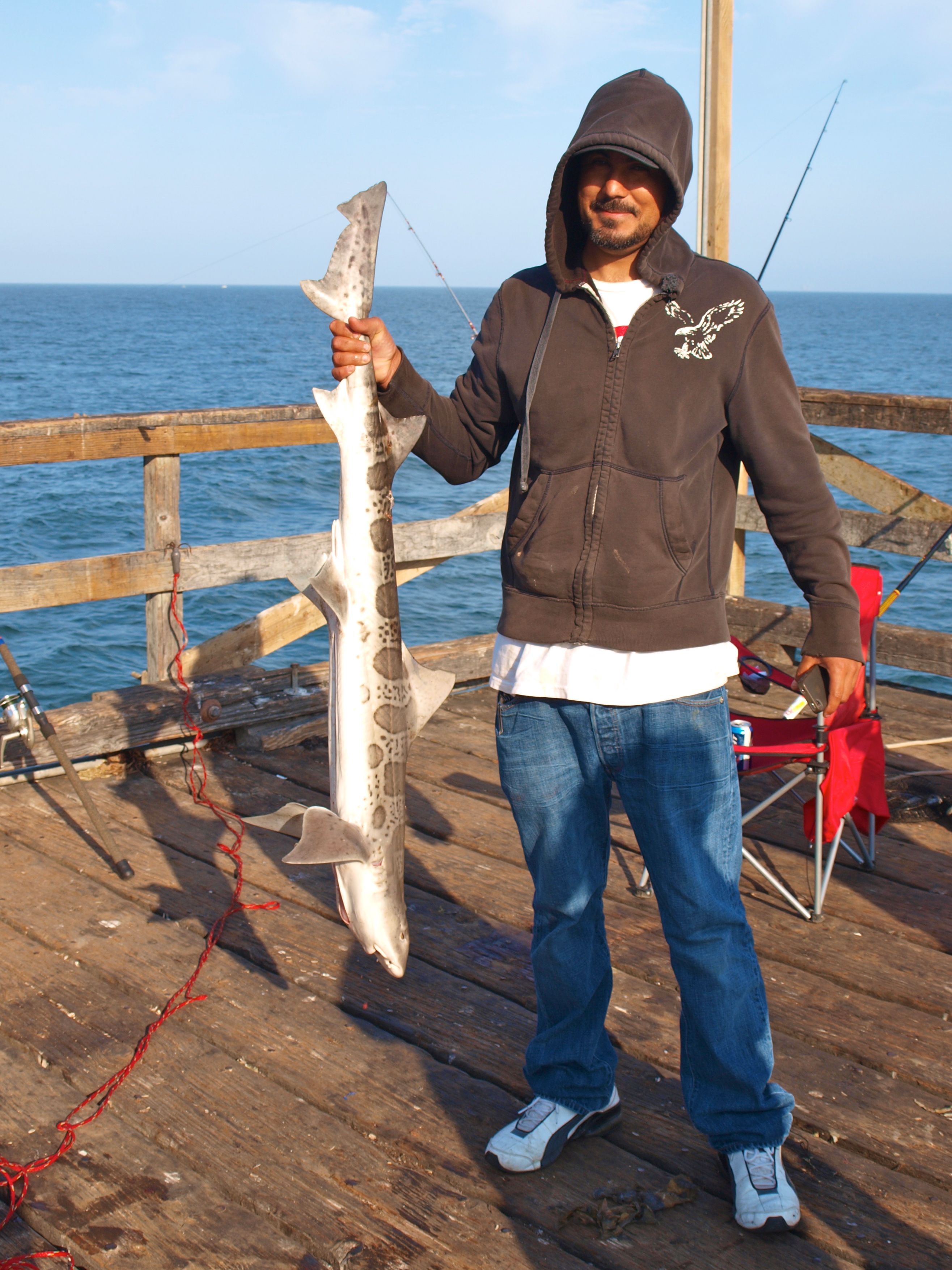
Leopard shark — 2013
Lastly, more and more people staying in the campground are becoming nighttime “shark” anglers, a response in part to the reputation the pier has gained for producing better-than-average number of selachians (sharks) and batoids (rays) — “sharays” to pier rats, sharks and rays to the less informed. Anglers will fish to the early hours of the morning (or all night) and then simply walk the short distance to their tents or campers when ready for bed.
Common selachians at the pier include smoothhounds, leopard sharks, spiny dogfish, angel sharks, swell sharks and horn sharks. Soupfin sharks (to near 6-feet and 100 pounds in size) and 7-gill sharks (to 7-feet and over a hundred pounds) are less common but occasionally seen whereas thresher sharks are a regular summertime visitor. While most of the threshers are mere pups, 6-7 feet in length, a few impressive 9-10 foot-long-fish have also been taken.

A soupfin shark caught by Polishfromthe deep
Batoids include such species as thornback rays (the most commonly caught species), round stingrays, bat rays, skates (a few), and shovelnose guitarfish. Bat rays approaching and sometimes exceeding 100 pounds in size are reported most years.
If seeking out the threshers come prepared with moderately heavy tackle and a way to get them up onto the pier. Most regulars slide a live mackerel down a slider rig for the long-tailed beauties; some will use a balloon or float to drift their bait out into deeper water. Threshers by the way seem to bite better during the day than at night and often seem to prefer a chop to the water. Given the winds at Gaviota, conditions are just about perfect for the threshers by most afternoons (at least during the summer).

Santa (Mike Spence) with a bat ray
The nighttime angling is often a special treat. Entire families will be out on the end of the pier. A few lanterns may be present (although there are some lights on the pier), and there will inevitably be a radio playing. (Hopefully, it will be playing some reasonable music or be tuned to a ballgame). Off in the distance will be the lights from the offshore oil wells and circling around the pier will be the birds that gave the area its name. Every so often an angler will hook a shark or ray; those present run to the railing, shine their flashlights down into the dark water, and then shriek out an identity as the fish comes into view. If in luck, the angler will be able to land the fish and then the story of “Jaws” and comparisons with past “monsters” begin.
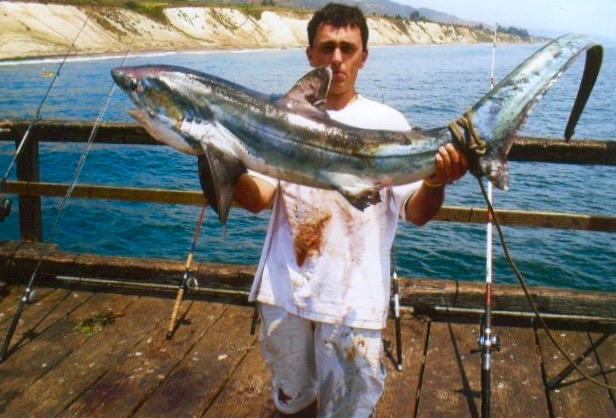
Thresher shark — 2007
Shark fishing, by the way, isn’t new here. An old newspaper story, dated September 1876, reports a shark being shot near Gaviota that measured over 10 feet in length. More recently there were reports of a large great white shark, estimated at nine feet in length that was chasing schools of baitfish—mackerel and jacksmelt—around the pier. No one hooked the giant fish but several gave it a try. Hard to say how they would have landed it if they had hooked it.


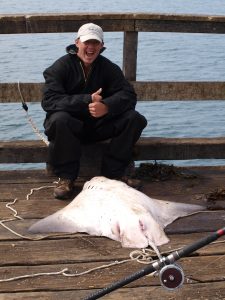
A young man fighting and landing a bat ray in 2009
One of the most unusual reports to the Pier Fishing in California Message Board, at least in regard to sharks, concerned a trip to this pier in August of 2000. Zorro, a long time reporter, reported that anglers using Lucky Lura bait rigs had taken two nearly-5-foot-long angel sharks. Both anglers were using chrome sinkers with hooks to weight the leaders and both sharks apparently hit the chrome sinkers. Angel sharks hitting chrome sinkers on the bottom of bait rigs? Two on the same day? Very, very rare indeed.
Gaviota Creek, just down the shoreline from the pier, does see steelhead trout some years and sometimes they will be in the inshore waters by the pier prior to winter rains opening the mouth of the creek. When conditions are right a fish will occasionally be caught from the pier. So, be sure to check current regulation if you land what appears to be a steelhead trout.

Anglers on the pier — 2009
Potpourri — Perhaps more than you want top know about the Gaviota Pier
<*}}}}}}}}}>< — An epiphany is defined as a manifestation or revelation and it has become a too-often-used New Age term. Nevertheless, it sort of describes the feeling that I had one mid-90s day while driving my trusty pickup to the pier (in Japan they would say this was a moment of satori—when all things became clear). The Octopus, a local radio station, was playing the Eagles’ “Hotel California” on my radio, and I had just passed Rufugio State Beach. I noticed my mileage gauge read 101 miles on HY 101 and then I saw a beautiful hawk sitting on the electrical lines that paralleled the highway. It was a perfect California morning and as I looked out toward the Pacific, and headed down “El Camino Real—The Kings Highway,” I reflected on the tranquility and beauty provided by my pier fishing trips along the coast. In many ways the coast and the piers had become my own personal Xanadu. What better way to see and understand the changes taking place in California, and to experience the joy while it still exists! I’ve often said pier fishing is more than just the fishing and that morning’s thoughts confirmed those feelings.
[Addendum — those thoughts have been tempered and deflated somewhat in the two decades since that day. The traffic, which once was fairly light along many parts of HY 101, now seems to stretch continuously from Santa Cruz south most of the day. In hopping from pier to pier, I have to plan “around” the traffic so that I do not spend a good portion of the day simply staring at the car in front of me.]
<*}}}}}}}}}>< — Fish surveys done by the Department of Fish and Game showed the following species (listed numerically from top to bottom): Pacific sardine, shiner perch, jack mackerel, barred surfperch, walleye surfperch, jacksmelt, black perch, Pacific mackerel, topsmelt, calico surfperch, rubberlip seaperch, rainbow seaperch, white perch, bat ray, pileperch, senoriya, silver surfperch and dwarf perch. (However, Pacific Sardine were only recorded for one year). The only species listed every year were barred surfperch and walleye surfperch.) I’m convinced that the “fish counters” were not visiting the pier at night. If they had there would assuredly be several additional shark species recorded.
<*}}}}}}}}}>< — My personal records show very high totals for the pier (from 1978 to 2013), a 12.9 fish per hour total and a 23.0 points per hour total (a figure based on quantity and quality). The latter figure, which is how I usually rate piers, would rate third in the state. Included were 28 species which numerically would be as follows: Pacific mackerel (almost double any other fish), shinerperch, jacksmelt, walleye surfperch, Pacific sardine, speckled sanddab, cabezon, bocaccio, jack mackerel, topsmelt, black perch, rainbow seaperch, kelp perch, California lizardfish, barred surfperch, thornback ray, staghorn sculpin, rubberlip seaperch, onespot fringehead, pileperch, reef surfperch, white perch, blue rockfish, kelp rockfish, rock wrasse, giant kelpfish, senorita, and fantail sole. Since I have never stayed at the park overnight my totals also do not show sharks as a catch.
<*}}}}}}}}}>< — The pier has been closed since 2014 — why? The following articles describe the reason for the closure. They do not describe why it has taken the state years and years to come up with repairs.
Gaviota Pier collapsed into ocean, State Parks official confirms
Part of the pier at Gaviota State Beach, a popular and unique spot where people can launch boats themselves, collapsed into the ocean at about 8 a.m. today.
State Parks Sector Superintendent Eric Hjelstrom said a boat hoist on the pier remains intact, but he fears that more damage could be done. He said no boats were docked at the structure and nobody was hurt in the collapse. The beach and pier are currently closed for safety reasons. Buellton resident Michael Rodrigues posted video on Facebook showing a chunk of the pier floating in the ocean. “There goes the pier. There goes the pier,” someone says on the video. —Lompoc Record, March 1, 2014
Solvang man describes Gaviota Pier collapse
Watching the Gaviota Pier collapse into the furious Pacific Ocean on Saturday is something Solvang resident Jack Crouch won’t forget anytime soon, and he has cell phone video of it to relive the experience. “It was pretty awesome,” he said Monday. The 28-year-old said he’d gotten a surf report on his cell phone Saturday morning about the high surf advisory and wanted to check it out. He picked up his 6-year-old daughter, Morgan, from a friend’s house and they headed down the coast to Gaviota State Beach.
When they arrived, the beach was closed and no one else was around. Crouch parked close to Hollister Ranch and they walked down carefully toward the pier — Morgan on her dad’s shoulders. The parking lot was filled with ocean water, Crouch said. “It was really muddy,” he said.
The waves appeared normal and the tide was high, he said. They walked toward the end of the pier and Crouch began shooting video on his cell phone as the waves got higher. The pier began shaking, which got Morgan excited, Crouch said. “She thought it was like a ride at Disneyland,” he said. When water began splashing up through the wooden pier, Crouch said he was not concerned about the pier washing away.
Crouch continued to shoot video as they walked away from the end of the pier, which was swaying back and forth. About 10 minutes later while standing on the side of the railroad tracks, Crouch and his daughter began to see pieces of the pier disappearing into the ocean. “’Morgan, we got to watch this,’” Crouch recalled saying. The large yellow boat hoist was spared from the damage, he said.
Crouch said he sent the video to his brother-in-law who sent it to a friend, Buellton resident Michael Rodrigues, who planned to launch a boat from the pier in a few weeks. Rodrigues posted the video on Facebook where it has been shared more than 1,000 times and the video was featured on local TV news. —Julian J. Ramos, Lompoc Record, March 6, 2014

Santa Barbara’s only real storm of 2014 destroyed the last 100 feet of the pier at Gaviota State Park on March 1, and the structure — beloved by both those who fish from the wharf and the boat owners who use its hoist to access the remote reefs and surf breaks of the adjacent Hollister Ranch — has been closed ever since. And while State Parks is taking the diligent steps toward reopening the popular recreational resource, which is the only launching spot between the harbors of Santa Barbara and Port San Luis, don’t expect it to open anytime soon: The project could cost as much as $20 million, and even if that money was already in the bank, the project would take more than a year to complete.
“It’s a very important facility, not only for Gaviota State Park, but for the region,” said State Parks’ Rich Rozzelle, who supervises this stretch of coastline. “It provides access to a stretch of coast that’s very rich in history and marine life. There are a lot of people, including State Parks, who want to see it reopened.”
Rozzelle commissioned a study on possible repair options, and his staff is analyzing that now while also identifying funding possibilities. The range of fixes goes from basic repairs that only cost a couple of million but wouldn’t add the remaining 100 feet or include a hoist to a full concrete pier build-out, which is where the $20 million figure comes in.
Though many Hollister Ranch property owners — who enjoy a private, behind-guarded-gates, idyllic California coast experience — are notorious for opposing easy access to their beaches and breaks, Rozzelle has not heard of any actual opposition to fixing the pier. He also doesn’t foresee trouble in permitting or environmental review, as State Parks employees process pier rebuilds often, but there will be a struggle in finding funding in the competitive state budget environment. There will likely be access improvements for the disabled when the repairs do happen, but the biggest expense will be the basic structural improvements.
“Without funding, it’s premature to give specific dates,” said Rozzelle, who believes it will take about a year to develop the plans to put out to bid. “If we had the money sitting in the bank today, we’d probably be 12 months out and more like 16 months.” —Santa Barbara Independent, Matt Kettmann, August 22, 2014
<*}}}}}}}}}>< — One of my favorite visits to the pier took place in July of 2003 following a PFIC/UPSAC Get Together at Goleta. It would not prove to be a particularly productive visit; in fact it was one of my worst. However, the surroundings, the chance to fish with a fellow pier rat, and the capture of at least one decent-sized fish guaranteed a blissful experience and the following PFIC Message Board report.
Gaviota Pier: July 13, 7-10 A.M. It was picture-postcard conditions when I arrived at the pier with a clear sky, just a hint of wind, and a flat sea. Then, as I began to walk the pier, I noticed a duo of dolphins swimming gracefully along the mild line of the surf—a beautiful sight. But only one other angler was present on the pier, which generally isn’t a good sign, and as I stopped to talk to him I found out why: fishing had been slow. He himself had not had a nibble all morning.
Nevertheless I headed out on the left side (looking seaward) to where there was a couple of old pilings covered with kelp (near a spot where, I believe, some repairs had been made a few years previous). The spot looked really fishy even if a little risky. Risky? Thick kelp surrounded the pilings and as the ocean surged, thick tendrils of kelp would envelop those same pilings. Could I drop a rig down into that spot without losing the rig? Could I land a fish if one decided to grab a bait? But, I was convinced fish were there, the spot was a natural. And it demanded attention even with the risk (and the chance for fish is always worth the risk). If a fish decided to hit I would need some luck, and perhaps need to say a silent prayer or two, but perch and rockfish are two of my favorite fish and this spot seemed perfect for both.
I dropped a high/low rig, size 6 hooks, and one-ounce torpedo sinker straight down into the maelstrom of activity betwixt and between those pilings. Almost immediately I began to get bites on my fresh mussel bait but it was the wrong kind of fish. Shiners and walleyes were thick and although most were at a mid-depth position, they seemed to like nothing better than to follow my mussel bait all the way to the bottom where the big perch would be lurking. I could have switched to larger baits and bigger hooks but was hoping for some of those bigger perch and they like small hooks.
Soon after, a few anglers did begin to show up. A couple tromped out to the end where they begin to use Sabiki-bait rigs to land an occasional sardine and jacksmelt; most set up shop along the sides of the pier in pursuit of whatever.
About that time Glen (Songslinger) showed up (see the picture of the halibut above) from the previous day’s gathering at Goleta and I thought perhaps a new Get Together might be in the works; but no, we would be the lone duo from the PFIC board. He was nearly out of bait and wanted some fresh bait so he headed down to the beach to catch some sand crabs. I continued to search out that big perch—and I found HER.
Out in that “spot,” right where I knew the fish would be, I had a hard hit, reared back and felt both a fish and the kelp on my line. At first I thought I might have lost her but I could feel the fish tugging and sure ’nuff she worked herself free. I got her to the top and it was a good-sized rubberlip that I soon hand-lined up to the top (since I didn’t have a net with me). She was long and thick, oh so thick, but as soon as she got on the pier she started squirting out her young. Yes, she was a gravid female ready to birth and I knew I would need to release her. So, as quickly as I could, I took a fast picture, and dropped her and her offspring back into the water. I hated to drop her down from the pier but had no other choice since I lacked the net. Happily, she seemed to take right off and swim away. I didn’t measure or weigh her but I’m sure she weighed at least three pounds; she looked bigger than that but looks can be deceiving. Songslinger, by the way, saw the fight from the beach and saw she was a good fish.

Rubberlip Seaperch
Everything after that was anti-climatic until Glen himself returned and managed a nice, legal-size halibut using a lively shiner perch and his new leader technique. I provided the bait, he provided the brains, and soon I heard (in a low voice)—“Ken you want to come here?” He didn’t want to awaken the entire pier but did want to show me that hallie he was bringing to the top—and show me a hallie yawn. He was going to break it off but before we had the chance a newly arrived angler rushed over with a net. Soon a 22-inch fish joined us on the pier and after a quick measurement and picture she too was returned to the water. Not too shabby for these old pier rats, a long way from home—a nice sized rubberlip and a legal hallie.
Shortly thereafter I ran out of the mussel I was using for bait, switched to the night crawlers, and the shiners went crazy. The problem now became one of keeping them off the hook but I was unsuccessful. We continued to fish and watched a beautiful family of dolphins, as well as a playful sea lion, but soon the wind returned to its normal Gaviota intensity and we both decided to call it a day. Glen headed home while I headed north to Pismo for some more fishing. Net result at the pier: 17 assorted small perch—walleyes and shiners, one bocaccio, one cabezon, one thornback ray, and one good rubberlip perch. As said, not a great day fish wise, but still a wonderful day.
By the way, when I developed the pictures of Songslinger and his halibut I noticed a face on the Gaviota cliff behind him. Asking the message board for their thoughts on the face elicited the following: (1) Songslinger himself—“it’s a Sphinx Eel?” (2) pescare—“Looks like a Dr. Seuss character that’s about to eat Slinger’s head!… “But in California, it’s a state law that any form that resembles a face must be deemed the Virgin Mary. I’m headed down to set up a hot dog cart to feed the masses that come to worship. It’s never a dull moment.” Every time I visit the pier I now take a look up at the face on the cliff but it’s slowly changing as the years go on.
<*}}}}}}}}}>< — Given that I once was a teacher, I absolutely love it when I hear that a fellow teacher has taken students fishing. You know my reaction when I read the following.
Date: October 7, 2005; To: PFIC Message Board; From: marsfan; Subject: Gaviota: First post Jr. Pier Rats
Arrived at Gaviota Pier at 1 P.M., and after taking the Pier Rat oath from Ken’s book, eight young new anglers from my middle school took to the pier. We fished until 4 P.M. An amazingly progressive-thinking director actually OK’d my request to teach a pier-fishing elective! These kids meet in the classroom Mon.-Thurs. for 50 mins. Learning to tie knots, rig for certain fish, casting, rod and reel maintenance, fishing regulations and etiquette, etc. Then on Friday afternoon, they put their knowledge to work. Here is their first post (combined numbers from two Fridays):
Short report: 31 mackerel, 33 smelt, 16 sand bass, 6 sand dabbers, 3 sculpin, 2 SBRF, 2 walleyed surfperch, 1 lingcod, 1 cabezon, 1 thornback ray. All fish were C&R except for 1 perch and 6 mackerel that were promptly cleaned, then taken home for dinner. The favorite quote from each angler is something that I overheard him or her say, and I added it to his or her report. — Donna
Long report: Angler — Fluffy (age 11): 3 Pacific mackerel, on Sabiki, using shrimp. Favorite quote: “cursed decisions!” (When trying to decide whether to use shrimp or squid as bait) — Angler: OneAfterAnother (age 12): 11 Pacific mackerel, 17 jacksmelt all on Sabiki with and without shrimp. Favorite quote: “I just saw the fish following the other guy’s Sabiki, so I cast mine out right behind his.” — Angler: KillerShark (age 11): 16 Sand bass, 2 mackerels, and 10 jacksmelt. Favorite quote: “I think I caught this fish before.” — Angler: Hobbit (age 13): 2 Walleyed perch, shrimp on #6 hook, Carolina rigged, 2 mackerel, 1 smelt and 1 baby lingcod, all on unbaited Sabiki. Favorite quote: “And that old guy thought I couldn’t fish.” — Angler: Bubbles (age 12): 5 Mackerel, 2 small brown rockfish on #8 hooks baited with squid, Carolina rigged, 1 sand dabber on Sabiki. Favorite quote: “Are we going to use our bikini’s to catch fish?” — Angler: LureGuy (age 12): 3 Mackerel on Sabiki with squid, 2 Pacific mackerel on #6 hooks with squid, high low leader. Favorite quote: “Look at them following my lure… bite it! Bite it!” — Angler: Swordfish7 (age 12): 2 sculpin, 1 sand dabber on #6 hook with squid, Carolina rigged, 1 cabezon (8 1/2 in) on high low leader with squid. Favorite quote: “Fishing is just the best, period.” — Angler: Redneck (age 13): 3 Pacific mackerel, 5 smelt on Sabiki, 1 sculpin and 4 sand dabbers on #8 hooks with squid, Carolina rigged, 1 thornback ray on high low leader with squid on #2 circle hook. Favorite quote: “this sure beats bein’ at school!”
Posted by HoodCanal
Wish there were teachers like you at my school when I was their age. Great work. Are you the “old man” that thought Hobbit couldn’t fish? Haha
Posted by Corki
I think that’s awesome. I wish we had something like that down in Sc. Keep it up; p
Posted by Ken Jones
I love it! Great work! We need more teachers out there taking their kids fishing. It helps establish a bond that will last a long, long time.
Posted by pierhead
16 sand bass? Wow—haven’t seen any at Gaviota for some time … where were they caught and what bait(s)?
Posted by pierhead
Got the answer already… met up with Marsfan (Donna) and her student KillerShark (Ryne) at Santa’s Guadalupe Perch Derby (more later) … those were sand bass he was catching. Said they were on the small side (8″-10″) though. Caught them straight down off the pilings at the end I think using a Sabiki rig. Makes me wonder if I shouldn’t be casting back under the pier… I mean it is the most obvious structure around.
<*}}}}}}}}}>< — Several times over the years gray whales have become stuck between the pilings of the pier. The latest was in the winter of ’99 when a 40-foot-long adult apparently became wedged between the pilings as it was feeding on the bottom. Seems the whale could go forward but couldn’t go in reverse. Local reports said “mothers and their calves often pass close to the park to feed on the sandy bottom, sucking up sand crabs and other shellfish.”
The tale of the whale really isn’t a funny story but it reminds me of a clipping which I cut out of a newspaper one day. The article’s headline said, “Fisherman catches Norwegian submarine.” Oslo, Norway—Skipper Ketil Tetlie thought he’d made the catch of a lifetime when something big—really big—started pulling his trawler backward off Norway’s northwestern coast.
“At first we thought it was a whale, but no whale could have pulled up backwards that fast,” Tetlie, said from his boat, the Ke-To, off northwestern Norway’s Lofoten Islands. Then his prize—a Royal Norwegian navy submarine—broke water. The 35-foot, 20-ton Ke-To was pulled backwards for about 1,000 yards by the 148-foot sub, the Svenner, which weighs about 500 tons. Neither vessel was damaged during Wednesday’s mis-hook, which occurred about 125 miles north of the Arctic Circle. “We threw it back,” joked Tetlie. “The price of steel just isn’t good enough to make it worth keeping.”—Contra Costa Times, May 15, 1998.
<*}}}}}}}}}>< — Source books give the geographic range of the lavender sculpin (Leiocottus hirundo) as being from Gaviota Pier in the north to northern Baja in the south (which is a pretty short range if I’m interpreting the information correctly). I assume this means that one (or more) of Gaviota’s pier anglers have caught one of the sculpins, a small fish that reaches about 10 inches in length.
Another unusual catch at the pier was a steelhead taken in the summer of ‘99. It’s hard to say what the iron headed trout was doing at the pier although a small creek does run through the campground.
<*}}}}}}}}}>< — California Fish Bulletin #96 from 1953 says, “One mile west of Gaviota, at the mouth of Nojoqui Creek, is the Gaviota Beach County Park. Here a new sport fishing pier, with light hoist, has been erected. Access to the pier is through the park. Four miles east of Gaviota there is a railway siding called Linto. There is no town, but one fisherman lives nearby and records his landings as Linto. He lands a few pounds of lobster, smelt and rockfish.
There is an oil company pier at this point [Gaviota] at which moderate quantities of fish have been landed for many years past but most of the poundage was credited to Santa Barbara… Before World War II, two boats made this point headquarters and delivered lobsters and some white seabass that was caught by trammel nets. At present two fishing boats land their catches at the pier, chiefly lobster… Sport fishing at the pier is minor.”
<*}}}}}}}}}>< — Like many piers, Gaviota has made it into the movies!
“In John Milius’ Big Wednesday, Gaviota State Park’s pier is home to the fabled Malibu Workshop of surfboard maker “Bear” (Sam Melville). In Sideways, Paul Giamatti and Thomas Haden Church reflect on life’s failures under Gaviota’s railroad trestle.”
—Harry Medved with Bruce Akiyama, Hollywood Escapes, 2006
<*}}}}}}}}}>< — The 811-foot wooden railroad trestle that sits 80-foot-high above the park is considered a landmark by Amtrak and is one of the most photographed railroad trestles in America. It was built in 1900 by the Southern Pacific Railroad to span Cañada de la Gaviota and Gaviota Creek’s outlet into the Pacific. It was one of the last trestles built between Los Angeles and San Francisco.
History Note. In 1874 a 1,000-foot-long wharf was built on this site for Colonel William Hollister and the Dibblee brothers (who had also loaned money and influence for the construction of Stearns Wharf in Santa Barbara). Their wharf, the Gaviota Wharf, reached water that was 25 feet deep at the end of the wharf and it was considered one of the safest local shipping ports. The area around the wharf also became an important area with early records recording a considerable business, primarily in livestock, wool, farm produce and lumber. Because of its safety record, the “Gaviota Landing” became a weekly destination for the coastal San Francisco steamers.
A report in the March 14, 1905 Los Angeles Herald said — “Special to the Herald, Gaviota, March 13.— The wharf, including a valuable warehouse has been carried away by the heavy sea and much freight has been lost.” Apparently the wharf was rebuilt because later reports said it was destroyed by a storm in 1912.
Of interest are early records (1883) that report, “a peculiarity of this wharf, or rather this location, is a strong off-shore wind, a cold blast always coming down the pass; consequently no vessel is thrown against the shore.” Yes, it was windy even then.
Apparently a second name for the original pier was Port Orford and it’s still listed on the populated place index for Santa Barbara County. According to Durham’s Place Names of California’s Central Coast: “Port Orford [Santa Barbara]: locality 0.5 mile west of Gaviota along the coast at the mouth of Cañada de la Gaviota 9lat.34-28-15 N. Long. 120-12-40 W). Site named on Gaviota (1953) 7.5’ quadrangle. Farmers shipped their products from Gaviota Wharf, a 1,000-foot-long pier at the place, from 1875 through the 1890’s (Rife, p.104).”

The current Gaviota Pier was originally built as a crash boat pier by the Navy in 1943. Records show that it was 420-foot-long but newspaper accounts, dated 1953, reported a proposal to lengthen it by 210 feet so that it would reach out into deeper water. It was evidently remodeled in 1953 and repaired again in 1987.
Damage to the pier and parking lot from the El Niño storms in the winter of 1998 necessitated closing the park for a period of time. When it finally was reopened, only the front half of the pier was available to anglers. The pier did not open to its full length until May of 2000. Today the pier is owned and operated by the state and the listed length is 529 feet (although some sources say 570 feet).

Gaviota Pier Facts
Hours: Day use is 6 a.m. to 10 p.m. Campers can fish all night.
Facilities: The pier has a few lights, fish-cleaning facilities, and a boat launch. Just down the hill from the pier are restrooms, parking, a general store which has both snacks and bait and tackle, and the campground. The pier is in Gaviota State Park; the day-use fee is $5.
Handicapped Facilities: Handicapped parking and restrooms. The pier surface is wood and the rail height is 42 inches. Posted for handicapped.
How To Get There: From Highway 101 simply take the Gaviota State Park turnoff.
Management: California Department of Parks and Recreation.
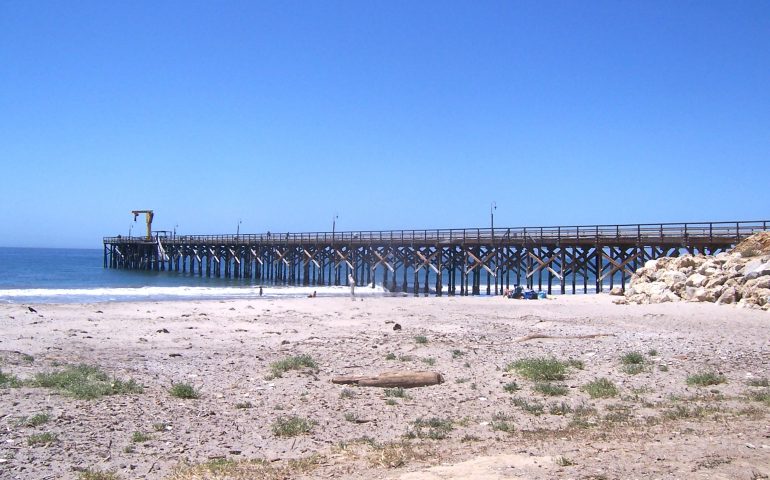
Open up the pier its been 5 yrs really
Open up the damn pier already—it’s been EIGHT LONG YEARS!!
Bsports dần khẳng định vị thế là sân chơi cá cược trực tuyến uy tín, hấp dẫn nhờ hệ sinh thái đa dạng và nhiều ưu đãi. Bài viết dưới đây sẽ mang đến góc nhìn chi tiết cho bạn.